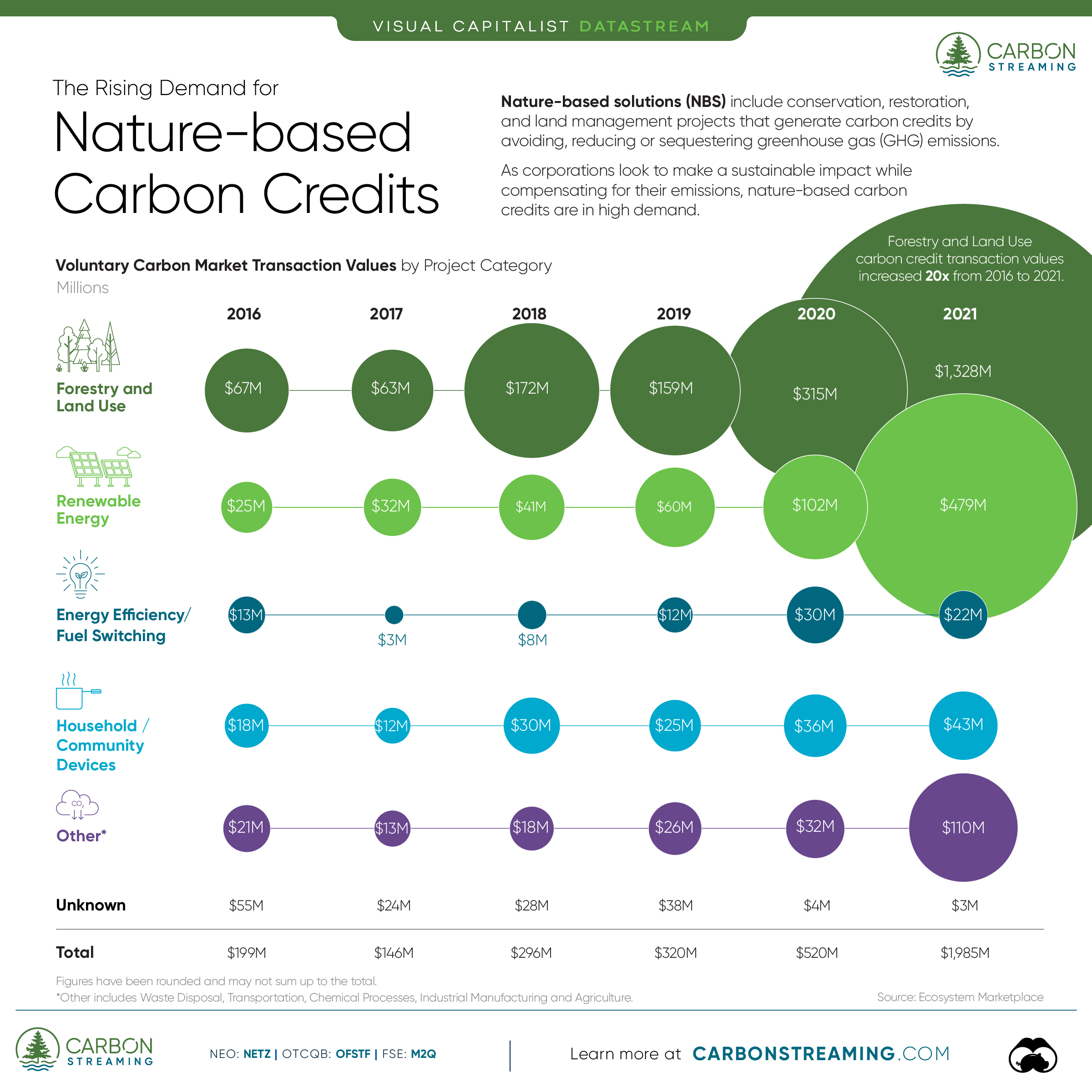
The following content is sponsored by Carbon Streaming Corporation.
The Briefing
- Nature-based climate solutions include conservation, restoration, and land management projects that avoid, reduce or sequester greenhouse gas emissions.
- Carbon credits from nature-based projects accounted for over 66% of transaction value in the voluntary carbon markets in 2021.
The Rising Demand for Nature-based Climate Solutions
The world’s forests are important carbon sinks that absorb a net 7.6 billion tonnes of carbon dioxide equivalent (CO2e) annually.
Therefore, regrowing, preserving, and managing forests and other natural carbon sinks is crucial to achieving net-zero emissions by 2050, and nature-based climate solutions are one way to do so.
Nature-based solutions refer to conservation, restoration, and land management projects that generate carbon credits by avoiding, reducing or sequestering greenhouse gas (GHG) emissions. With more organizations committing to climate targets, carbon credits from these projects have been in high demand.
The above graphic sponsored by Carbon Streaming Corporation looks at the growing demand for carbon credits generated by nature-based projects using data from Ecosystem Marketplace.
The Growth of Nature-based Carbon Credits
With the race to net-zero ramping up, carbon markets have been growing as a whole.
In fact, the value of total transactions in the voluntary carbon markets in 2021 reached nearly $2 billion—more than tripling since 2020. Forestry and Land Use carbon credit projects led the growth, accounting for over 66% or over $1.3 billion worth of transactions in 2021.
Here’s a full breakdown of transaction values by project category:
| Transaction Year | Forestry and Land Use | Renewable Energy | Energy Efficiency / Fuel Switching | Household / Community Devices | Other and Unknown | Total |
|---|---|---|---|---|---|---|
| 2016 | $67M | $25M | $13M | $18M | $76M | $199M |
| 2017 | $63M | $32M | $3M | $12M | $37M | $146M |
| 2018 | $172M | $41M | $8M | $30M | $46M | $296M |
| 2019 | $159M | $60M | $12M | $25M | $64M | $320M |
| 2020 | $315M | $102M | $30M | $36M | $36M | $520M |
| 2021 | $1,328M | $479M | $22M | $43M | $113M | $1,985M |
Figures have been rounded and may not sum up to the total.
Forestry and Land Use projects manage forests, soil, grasslands, and other land types to avoid or reduce carbon emissions or increase carbon sequestration. These projects generate one carbon credit for every tonne of CO2 equivalent GHGs that they remove or avoid from entering the atmosphere.
At the same time, they may offer co-benefits that can advance the UN Sustainable Development Goals through improvements in biodiversity, soil health, air and water quality, and the livelihoods of local communities.
Therefore, Forestry and Land Use projects have a significant role to play in reaching net zero. In fact, according to research published in the scientific journal Nature, letting forests regrow naturally has the potential to absorb up to 8.9 billion tonnes of CO2 annually through 2050, while still maintaining native grasslands and current food production levels.
Nature’s Role in Reaching Net Zero
For organizations looking to achieve their sustainability goals, nature-based solutions offer an opportunity to preserve and restore critical carbon sinks while supporting biodiversity and local communities. As a result, these types of carbon credits often trade at a premium, and their demand is skyrocketing, especially with more corporations committing to sustainability.
Carbon Streaming aims to accelerate a net-zero future. It pioneered the use of streaming transactions, a proven and flexible funding model, to scale high-integrity carbon credit projects to accelerate global climate action and advance the United Nations Sustainable Development Goals. It focuses on projects that have a positive impact on the environment, local communities, and biodiversity, in addition to their carbon reduction or removal potential.
>>>Interested in learning more about Carbon Streaming? Click here to learn more.
Where does this data come from?
Source: Ecosystem Marketplace
The post The Rising Demand for Nature-based Climate Solutions appeared first on Visual Capitalist.